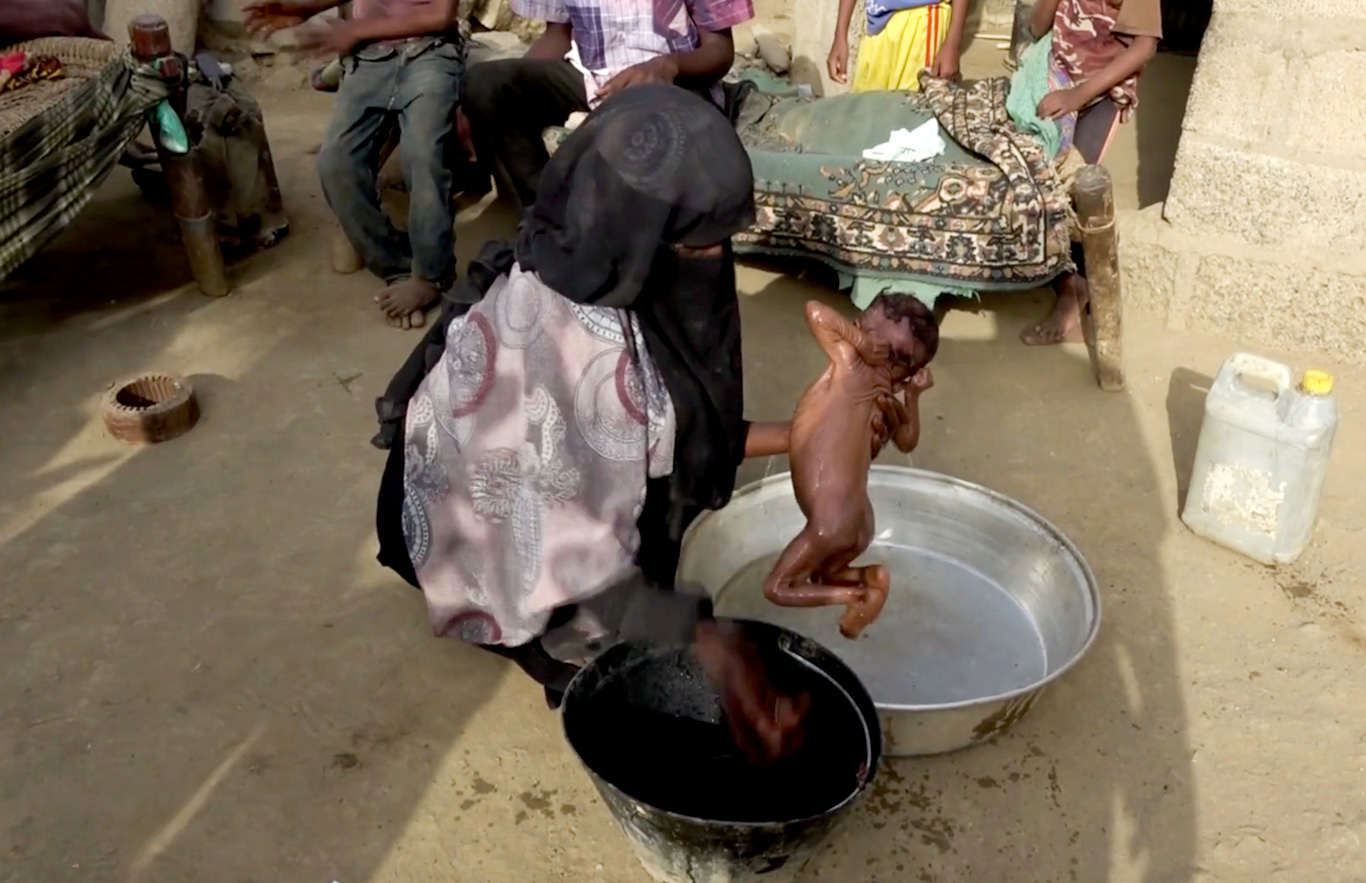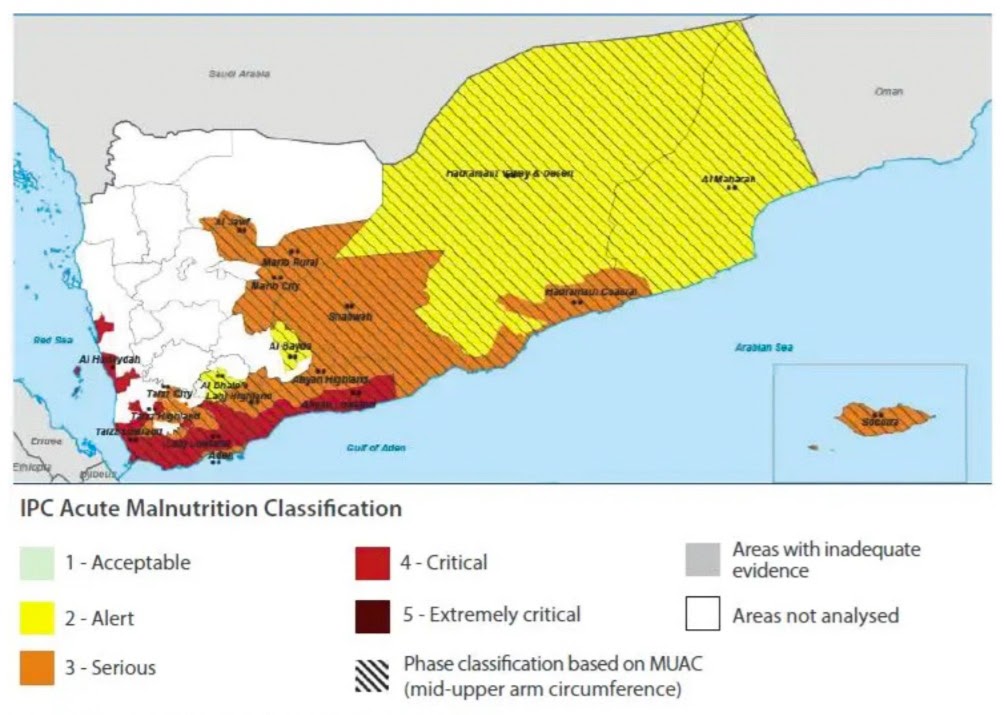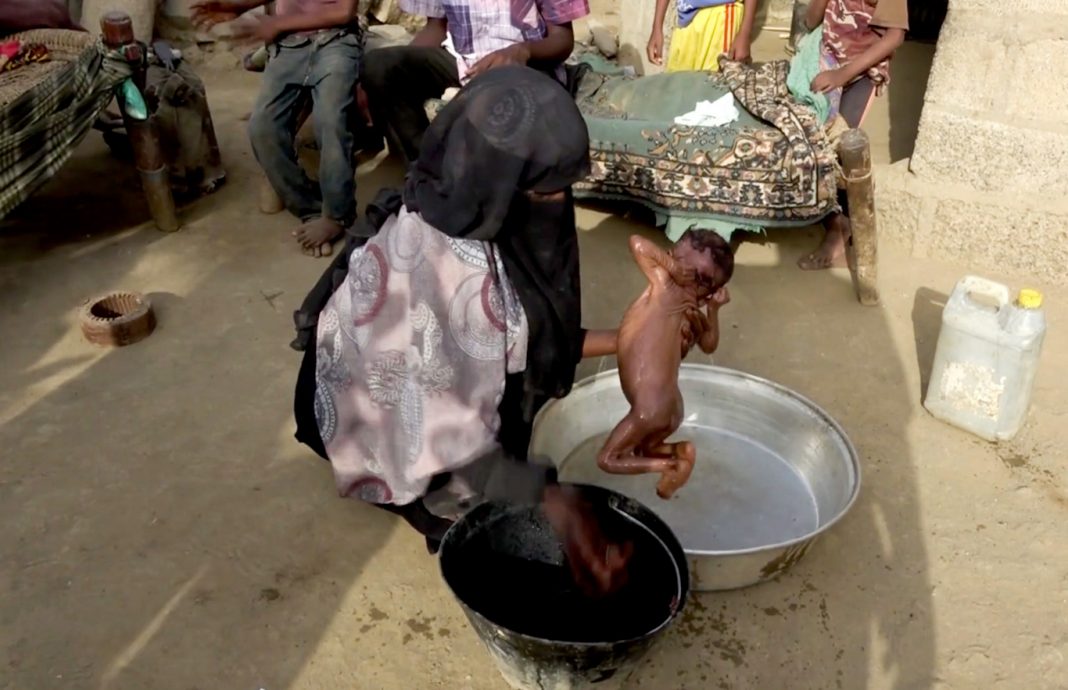TAIZ, YEMEN- – Both Saudi Arabia and the United Arab Emirates seem to be doing everything in their power to prevent an end to the suffering in Yemen. Even those living in areas under the total control of the wealthy Gulf monarchies are facing levels of devastation that harken back to the total destruction of European cities during World War II.
With no functioning government to provide residents with even basic assistance and facing a collapsed economy amid a famine that could soon beset all of Yemen according to the United Nations, the collapse of Yemen’s rial, particularly in Saudi-coalition-controlled areas, is proving to be the coup de grâce that will assure the country faces an apocalyptic level of destruction for years to come.
Her black eyes virtually absent and speaking in a muted voice that is difficult to pick up, Umm Abdu does her best to recount her story to MintPress. She was hiding a bony face and emaciated body in a voluminous black abaya robe and hijab. “I am starving myself to feed my children. It is very difficult to reach for this piece,” the Illiterate mother of six muttered as she held a piece of Roti bread. Umm Abdu lives in a poor neighborhood in Taiz, a city in western Yemen under the control of some of the richest countries in the world.

Severely malnourished infant Zahra is bathed by her mother in a washtub. Hammadi Issa | AP
After nearly six years of war, Yemen remains home to the world’s largest humanitarian crisis. Millions are hungry and destitute and at least 80% of the population requires humanitarian assistance or protection. Some 13.5 million people face severe food shortages and that number could rise to 16.2 million in 2021, according to International Relief Bodies.
The economy has already collapsed for virtually every Yemeni living in the south, except for the few who managed to profit by working with Saudi Arabia or the UAE. Savings accounts have long been exhausted and by end of November, the rial depreciated to an all-time low of 850 YR to a single U.S. dollar, leaving most of the population unable to afford even the most basic essentials. Like Umm Abdu, people are reducing portion sizes and skipping meals as a kind of “coping strategy index,” one of many tools used to measure food insecurity. Fruit, fish, and meat have become a rare commodity that most can only dream of.
“Even though there is food in the markets, I can’t afford it. Not because we don’t have money, but because of the crazy prices. So we decide to reduce food to keep our children alive,” one shopper told MintPress. However, that strategy may not be enough as food prices are near double where they were in the wake of the recent currency collapse.
According to International organizations, Yemen, particularly areas under the control of Riyadh and Abu Dhabi, will return to alarming levels of food insecurity by mid-2020, and a catastrophic food security crisis is looming. They reported that by December 2020, the population facing high levels of acute food insecurity (what they termed IPC Phase 3 and above) would increase from 2 million to 3.2 million people.
An Integrated Food Security Phase Classification (IPC) report from October 2020 covering southern Yemen highlighted how acute malnutrition rates among children under five are now the highest ever recorded in some districts. The analysis reveals a near 10 percent increase in cases of acute malnutrition this year. The greatest increase is in cases of young children suffering from severe acute malnutrition which has increased by 15.5 percent, leaving at least 98,000 children under age five at high risk of dying without urgent treatment.
 Source: IPC Acute malnutrition analysis (Oct 2020)
Source: IPC Acute malnutrition analysis (Oct 2020)
A stream of statements from leading aid organization officials reflects how dire the situation has become, including a warning from UN Secretary-General António Guterres that “Yemen is now in imminent danger of the worst famine the world has seen for decades. ”We’ve been warning since July that Yemen is on the brink of a catastrophic food security crisis. If the war doesn’t end now, we are nearing an irreversible situation and risk losing an entire generation of Yemen’s young children,” said Lisa Grande last month,” the Humanitarian Coordinator for Yemen. “The data we are releasing today confirms that acute malnutrition among children is hitting the highest levels we have seen since the war started,” she added.
The Food and Agriculture Organization of the United Nations (FAO) raised the alarm about millions of Yemenis risking falling into worsening levels of hunger by mid-2021. The United Nations World Food Programme (WFP) also described the crisis in Yemen as “the world’s worst.” The WFP said in a tweet that millions are trapped in a cycle of conflict and hunger. “Everyday life in Yemen gets harder for millions as the window to prevent famine narrows. We must act now.”
Although a mass famine event may be unlikely in the immediate future, officials in Taiz warned that many areas could soon start to see deaths from famine. Many children already have signs of severe acute malnutrition, the most dire stage of hunger where legs and feet begin to swell. “We all sleep hungry, there is not enough food even for our children,“ Umm Abdu told us.
For Umm Abdu and her husband, 37-year-old Saeed, the rial’s collapse has meant skipping meals. Saeed was educated as an English teacher and had a job as a tour guide at a local travel agency before the war. Since he lost his job after the war began, he’s been making money selling qat – a mild stimulant that many Yemenis chew in the afternoon. However, that money is not nearly enough to cover rent, let alone basic needs. Now, their situation is getting worse as the availability of Qat has decreased dramatically after the weather turned cold three months ago when winter began. After the recent collapse of the rial, the ability to bring home food has become nearly impossible.
Umm Abdu and Saeed are now considering extreme options. Over the past six years, they have seen Yemen’s steady dissolution from a nation hoping to transition to democracy post-Arab Spring, to a nation fragmented and a land of warring statelets, mass suffering, and despair. Many of their neighbors have resorted to stealing, human trafficking, and selling their organs to make ends meet, or even marrying off their daughters because they are unable to feed them.
A tale of two cities
Officials in Aden, the de facto center of Saudi-Coalition power in Yemen, blame the collapse of currency on the fact that foreign reserves have dried up. According to them, remittances from Yemenis abroad, the largest source of foreign exchange, dropped by up to 70% as a result of the Covid-induced global downturn. But to Omer, a former fighter in “al-Muqawamah” in Aden who was wounded while fighting with Coalition Forces against the Houthis in 2016, these arguments are grossly inaccurate.
Omer believes that Saudi Arabia has a plan to destroy the national currency in order to intentionally accelerate famine. “Why is there no collapse of the currency in Houthi areas even though they live in conditions worse than us?” The exchange rate divergence between Houthi-controlled Sana’a and coalition-controlled Aden is indeed stark, with the Yemeni rial worth 35% less in Aden than it is in Sana’a.
Omer was one of the thousands of Yemenis that took the streets in Taiz and other areas this week in a mass protest against the continuing deterioration of the economic situation, denouncing the Saudi-led coalition states and demanding they leave the country. The demonstrators accused coalition countries and ousted Yemeni president Abdul Mansour al-Hadi of practicing a policy of starvation to achieve their personal objectives. They chanted slogans against Saudi Arabia and UAE with phrases like “our revolution is a hungry revolution,” “take your aid, and leave us our oil,” “take your donations, and leave us our ports,” and “take your trust fund and leave us our wealth.”
A gloomy future
According to local economists who spoke to MintPress, the reasons behind the collapse of Yemen’s economy and its currency are many and varied but the expansionary monetary policy that has been taken by Saudi Arabia is one of the key drivers of the Yemeni rial’s devaluation.
Local authorities supported by Saudi Arabia have regularly printed new banknotes in order to meet expenses compounded by the purchase of foreign currencies flowing into markets by foreign organizations.
By the end of 2019, the total rial liquidity in circulation in the country was more than three trillion, according to a source in the Aden-based central bank. As of the beginning of 2020, the bank has printed around 300 billion rials in order to address the budget deficit. The government of ousted president Hadi has largely relied on the central bank’s overdraft financing instrument to cover his spending abroad, including rent, travel, and entertainment.
Recently, Saudi’s proxies in southern Yemen have been selling large quantities of newly-printed banknotes in order to purchase foreign currency from the market and replenish their own foreign currency holdings. This has increased downward pressure on the rial’s value and helped drive inflation.
Secretary-General Antonio Guterres has called on countries to provide financial assistance to resolve the severe economic crisis in Yemen, saying in a statement issued via his spokesperson Stephane Dujarric on the second anniversary of the Stockholm Agreement, “I call on all member states to help address the severe economic crisis in the country.”
Umm Abdu has a gloomy future. She has no faith in the UN or the Saudi proxies in the south, who she described as “drenched in treason.” Nonetheless, she places hope in God and in her fellow Yemenis that her country will be freed. “Where else on Earth can you find a nation that has gone through what has happened in Yemen, occupied by foreigners, destroyed, with famine and epidemics, and yet somehow, we still managed to survive.”
Feature photo | Yemeni women display paper currency after receiving cash support from UNICEF. Hani Mohammed | AP
Ahmed AbdulKareem is a Yemeni journalist. He covers the war in Yemen for MintPress News as well as local Yemeni media.
The post Mass Starvation Looms as Yemen’s Currency Nears Historic Freefall appeared first on MintPress News.




